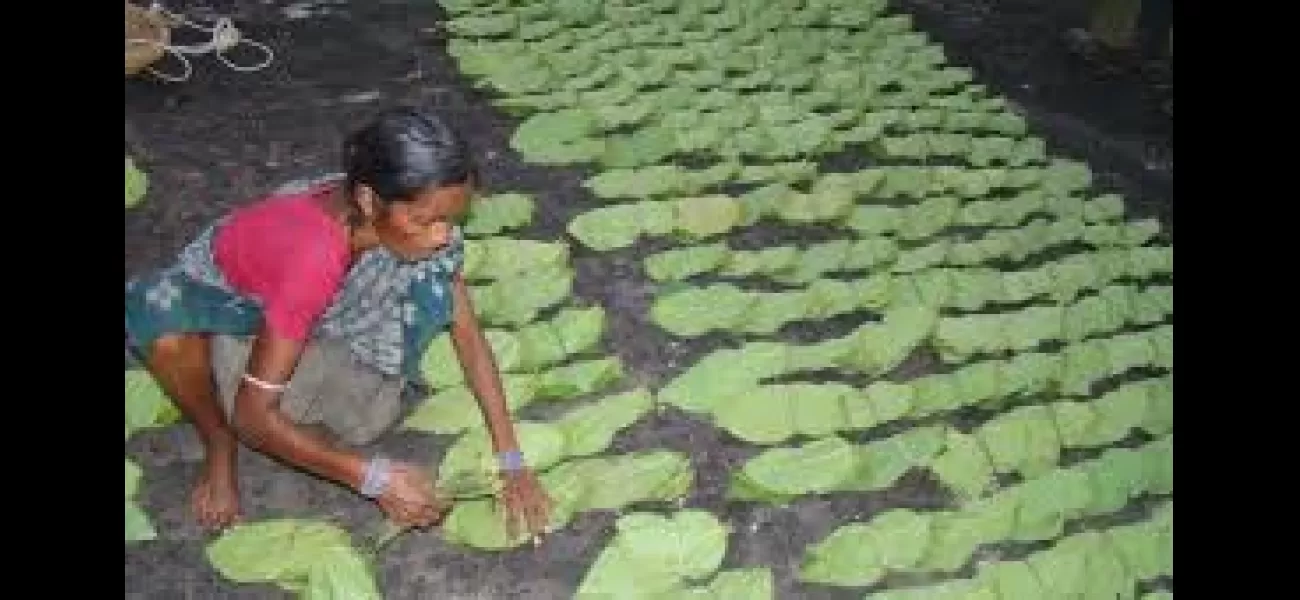There is no rush for green gold in Jharsuguda.
Kendu leaf business in Jharsuguda district is facing imminent closure due to climate change and rapid industrialization, resulting in a decline in collection of this important forest produce.
June 16th 2024.

The once-thriving kendu leaf business in Jharsuguda district is now facing a looming closure as a result of climate change and rapid industrialization. This western Odisha district, which was once in high demand for its kendu leaves, has seen a sharp decline in production due to these factors. It is a concerning situation as the once-profitable business may soon shut down completely.
Looking at the available data, it is evident that the production of kendu leaves has significantly decreased in the last few years. In 2017, 11,800.80 quintals were produced, but in 2021, the production was only 8,059.20 quintals. The target for 2022 and 2023 was set at 10,000 quintals, but the actual collection was only 8,632.80 quintals and 5,204 quintals, respectively. The decline in production is due to various reasons such as unseasonal rainfall, hailstorms, cloudy weather, industrialization, environmental pollution, and indiscriminate tree felling. If this trend continues, there are concerns that the production of kendu leaves may decrease further.
While other parts of western Odisha, such as Bolangir, Titilagarh, Padampur, and Rourkela, are seeing a booming collection of kendu leaves, Jharsuguda district is facing a steady decline. This is a cause for worry as the kendu leaf trade plays a significant role in the district's economy. The involvement of seasonal workers, munsis, chaurasi checkers, binding checkers, circle checkers, and head checkers is crucial in this trade.
The Jharsuguda kendu leaf division office oversees six kendu leaf range offices in the district, namely Jharsuguda, Belpahar, Kadamdihi, Kanika, Duduka, and Gopalpur. Kendu leaf trade has been under the department's control since January 1973, during the tenure of Chief Minister Nandini Satpathy. Apart from Jharsuguda, there are 19 other kendu leaf divisions in the state, providing employment to thousands of kendu leaf pluckers and seasonal workers.
However, the decline in kendu leaf production in Jharsuguda district has raised concerns. Every year, thousands of people rely on the kendu leaf season for earning a livelihood. The season begins in March, followed by bush cutting in April, repairing of kendu leaf depots in May, and plucking of leaves from June to October. The entire process is supervised by kendu leaf rangers, deputy rangers, foresters, and forest guards. The district has a total of 303 kendu leaf depots, but the demand for kendu leaf has significantly decreased since the industrial plants' establishment in 2000. The felling of lakhs of trees for these plants is considered one of the main reasons for the decline in availability of kendu leaves.
The lack of a favorable atmosphere is the primary reason behind the decrease in kendu leaf production. This has resulted in thousands of people losing their source of employment. The bush cutting for this year's kendu leaf season began on February 20, but due to unseasonal rainfall, there are concerns that the production may decrease even further. Another issue faced by the kendu leaf trade is the villagers collecting Mohua flowers, setting fire to the forest, and the smuggling of kendu leaf from the Bagdihi railway station. The seizure of kendu leaf by forest officials from this station three months ago is a prime example of this problem.
The state government provides a bonus to kendu leaf pluckers and seasonal workers from the profits earned from this trade. However, with the decline in production and the looming closure of the business, it is uncertain how these workers will sustain themselves in the future. It is crucial to address the issues of climate change, industrialization, and indiscriminate felling of trees to revive the once-thriving kendu leaf trade in Jharsuguda district.
Looking at the available data, it is evident that the production of kendu leaves has significantly decreased in the last few years. In 2017, 11,800.80 quintals were produced, but in 2021, the production was only 8,059.20 quintals. The target for 2022 and 2023 was set at 10,000 quintals, but the actual collection was only 8,632.80 quintals and 5,204 quintals, respectively. The decline in production is due to various reasons such as unseasonal rainfall, hailstorms, cloudy weather, industrialization, environmental pollution, and indiscriminate tree felling. If this trend continues, there are concerns that the production of kendu leaves may decrease further.
While other parts of western Odisha, such as Bolangir, Titilagarh, Padampur, and Rourkela, are seeing a booming collection of kendu leaves, Jharsuguda district is facing a steady decline. This is a cause for worry as the kendu leaf trade plays a significant role in the district's economy. The involvement of seasonal workers, munsis, chaurasi checkers, binding checkers, circle checkers, and head checkers is crucial in this trade.
The Jharsuguda kendu leaf division office oversees six kendu leaf range offices in the district, namely Jharsuguda, Belpahar, Kadamdihi, Kanika, Duduka, and Gopalpur. Kendu leaf trade has been under the department's control since January 1973, during the tenure of Chief Minister Nandini Satpathy. Apart from Jharsuguda, there are 19 other kendu leaf divisions in the state, providing employment to thousands of kendu leaf pluckers and seasonal workers.
However, the decline in kendu leaf production in Jharsuguda district has raised concerns. Every year, thousands of people rely on the kendu leaf season for earning a livelihood. The season begins in March, followed by bush cutting in April, repairing of kendu leaf depots in May, and plucking of leaves from June to October. The entire process is supervised by kendu leaf rangers, deputy rangers, foresters, and forest guards. The district has a total of 303 kendu leaf depots, but the demand for kendu leaf has significantly decreased since the industrial plants' establishment in 2000. The felling of lakhs of trees for these plants is considered one of the main reasons for the decline in availability of kendu leaves.
The lack of a favorable atmosphere is the primary reason behind the decrease in kendu leaf production. This has resulted in thousands of people losing their source of employment. The bush cutting for this year's kendu leaf season began on February 20, but due to unseasonal rainfall, there are concerns that the production may decrease even further. Another issue faced by the kendu leaf trade is the villagers collecting Mohua flowers, setting fire to the forest, and the smuggling of kendu leaf from the Bagdihi railway station. The seizure of kendu leaf by forest officials from this station three months ago is a prime example of this problem.
The state government provides a bonus to kendu leaf pluckers and seasonal workers from the profits earned from this trade. However, with the decline in production and the looming closure of the business, it is uncertain how these workers will sustain themselves in the future. It is crucial to address the issues of climate change, industrialization, and indiscriminate felling of trees to revive the once-thriving kendu leaf trade in Jharsuguda district.
[This article has been trending online recently and has been generated with AI. Your feed is customized.]
[Generative AI is experimental.]
0
0
Submit Comment





